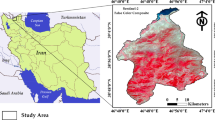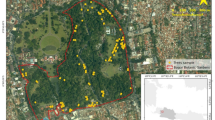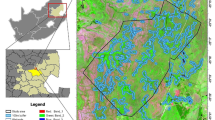Abstract
Invasive alien species threaten tropical grasslands and native biodiversity across the globe, including in the natural mosaic of native grasslands and forests in the Shola Sky Islands of the Western Ghats. Here, grasslands have been lost to exotic tree invasion (Acacias, Eucalyptus, and Pines) since the 1950s, but differing invasion intensities between these species and intermixing with native species constitutes a major challenge for remotely sensed assessments. In this study, we assess the accuracy of three satellite and airborne remote sensing sensors (Sentinel-1 radar data, Sentinel-2 multispectral data and AVIRIS-NG hyperspectral data) and three machine learning classification algorithms to identify the spatial extent of native habitats and invasive tree species. We used the support vector machine (SVM), classification and regression trees (CART), and random forest (RF) algorithms implemented on the Google Earth Engine platform. Results indicate that AVIRIS-NG data in combination with SVM produced the highest classification accuracy (98.7%). Fused Sentinel-1 and Sentinel-2 produce 91% accuracy, while Sentinel-2 alone yielded 91% accuracy; but only with higher coverage of ground control points. The hyperspectral data (AVIRIS-NG) was the only sensor that permitted distinguishing recent invasions (young trees) with high precision. We suspect that large areas will have to be mapped and assessed in the coming years by conservation managers, NGOs to plan restoration or to assess the success of restoration activities, for which a choice of sensors may have to be made based on the age of invasion being mapped, and the quantum of ground control data available.








Similar content being viewed by others
References
Ahmad SK, Hossain F, Eldardiry H et al (2019) A fusion approach for water area classification using visible, near infrared and synthetic aperture radar for South Asian conditions. IEEE Trans Geosci Remote Sens 58(2471):2480
Alempath M, Rice C (2008) Nilgiritragus hylocrius. IUCN Red List Threat Species 2008:e.T9917A13026736. https://doi.org/10.2305/IUCN.UK.2008.RLTS.T9917A13026736.en
Allan DG, Harrison JA, Navarro R et al (1997) The impact of commercial afforestation on bird populations in Mpumalanga Province, South Africa—insights from bird-atlas data. Biol Conserv 79:173–185
Arasumani M, Bunyan M, Robin VV (2021) Opportunities and challenges in using remote sensing for invasive tree species management, and in the identification of restoration sites in tropical montane grasslands. J Environ Manag 280:111759
Arasumani M, Khan D, Das A et al (2018) Not seeing the grass for the trees: timber plantations and agriculture shrink tropical montane grassland by two-thirds over four decades in the Palani Hills, a Western Ghats Sky Island. PLoS ONE 13:e0190003
Arasumani M, Khan D, Vishnudas C et al (2019) Invasion compounds an ecosystem-wide loss to afforestation in the tropical grasslands of the Shola Sky Islands. Biol Conserv 230:141–150
Armstrong A, Van Hensbergen H (1995) Effects of afforestation and clearfelling on birds and small mammals at Grootvadersbosch, South Africa. S Afr For J 174:17–21
Awad MM (2018) Forest mapping: a comparison between hyperspectral and multispectral images and technologies. J For Res 29:1395–1405
Bioresita F, Puissant A, Stumpf A et al (2018) A method for automatic and rapid mapping of water surfaces from sentinel-1 imagery. Remote Sensing 10:217
Breiman L (2001) Random forests. Mach Learn 45:5–32
Breiman L, Friedman J, Stone CJ et al (1984) Classification and regression trees. CRC Press
Burai P, Deák B, Valkó O et al (2015) Classification of herbaceous vegetation using airborne hyperspectral imagery. Remote Sens 7:2046–2066
Burges CJ (1998) A tutorial on support vector machines for pattern recognition. Data Min Knowl Discov 2:121–167
Burgess N, Butynski T, Cordeiro N et al (2007) The biological importance of the Eastern Arc Mountains of Tanzania and Kenya. Biol Conserv 134:209–231
Chaube NR, Lele N, Misra A et al (2019) Mangrove species discrimination and health assessment using AVIRIS-NG hyperspectral data. Curr Sci 116:1136
Chen B, Xiao X, Ye H et al (2018) Mapping forest and their spatial–temporal changes from 2007 to 2015 in tropical hainan island by integrating ALOS/ALOS-2 L-Band SAR and landsat optical images. IEEE J Sel Top Appl Earth Observ Remote Sens 11:852–867
Congalton RG (1991) A review of assessing the accuracy of classifications of remotely sensed data. Remote Sens Environ 37:35–46
Congalton RG, Green K (2019) Assessing the accuracy of remotely sensed data: principles and practices. CRC Press
Daehler CC (2005) Upper-montane plant invasions in the Hawaiian Islands: patterns and opportunities. Perspect Plant Ecol Evol Syst 7:203–216
de Abreu RC, Durigan G (2011) Changes in the plant community of a Brazilian grassland savannah after 22 years of invasion by Pinus elliottii Engelm. Plant Ecol Divers 4:269–278
Delalay M, Tiwari V, Ziegler AD et al (2019) Land-use and land-cover classification using Sentinel-2 data and machine-learning algorithms: operational method and its implementation for a mountainous area of Nepal. J Appl Remote Sens 13:014530
Donnelly J (1985) Community structure of epigaeic ants in a pine plantation and in newly burnt fynbos. J Entomol Soc S Afr 48:259–265
Dye P, Jarmain C (2004) Water use by black wattle (Acacia mearnsii): implications for the link between removal of invading trees and catchment streamflow response: working for water. S Afr J Sci 100:40–44
Erinjery JJ, Singh M, Kent R (2018) Mapping and assessment of vegetation types in the tropical rainforests of the Western Ghats using multispectral Sentinel-2 and SAR Sentinel-1 satellite imagery. Remote Sens Environ 216:345–354
Foody G, Hill R (1996) Classification of tropical forest classes from Landsat TM data. Int J Remote Sens 17:2353–2367
Gaertner M, Novoa A, Fried J et al (2017) Managing invasive species in cities: a decision support framework applied to Cape Town. Biol Invasions 19:3707–3723
George R, Padalia H, Kushwaha S (2014) Forest tree species discrimination in western Himalaya using EO-1 Hyperion. Int J Appl Earth Obs Geoinf 28:140–149
Gorelick N, Hancher M, Dixon M et al (2017) Google Earth Engine: Planetary-scale geospatial analysis for everyone. Remote Sens Environ 202:18–27
Hu S, Qin J, Ren J et al (2020) Automatic extraction of water inundation areas using Sentinel-1 data for large plain areas. Remote Sens 12:243
Iannelli GC, Gamba P (2019) Urban extent extraction combining sentinel data in the optical and microwave range. IEEE J Sel Top Appl Earth Obs Remote Sens 12:2209–2216
Joshi AA, Sankaran M, Ratnam J (2018) ‘Foresting’the grassland: historical management legacies in forest-grassland mosaics in southern India, and lessons for the conservation of tropical grassy biomes. Biol Conserv 224:144–152
Kattenborn T, Lopatin J, Förster M et al (2019) UAV data as alternative to field sampling to map woody invasive species based on combined Sentinel-1 and Sentinel-2 data. Remote Sens Environ 227:61–73
Laurin GV, Liesenberg V, Chen Q et al (2013) Optical and SAR sensor synergies for forest and land cover mapping in a tropical site in West Africa. Int J Appl Earth Obs Geoinf 21:7–16
Lawrence RL, Wright A (2001) Rule-based classification systems using classification and regression tree (CART) analysis. Photogramm Eng Remote Sens 67:1137–1142
Le Maitre DC, Gaertner M, Marchante E et al (2011) Impacts of invasive Australian acacias: implications for management and restoration. Divers Distrib 17:1015–1029
Ledgard N (2001) The spread of lodgepole pine (Pinus contorta, Dougl.) in New Zealand. For Ecol Manag 141:43–57
Lele A, Arasumani M, Vishnudas C et al (2020) Elevation and landscape change drive the distribution of a montane, endemic grassland bird. Ecol Evol 10:7755–7767
Lim J, Kim K-M, Jin R (2019) Tree species classification using hyperion and sentinel-2 data with machine learning in South Korea and China. ISPRS Int J Geo Inf 8:150
Lu L, Tao Y, Di L (2018) Object-based plastic-mulched landcover extraction using integrated Sentinel-1 and Sentinel-2 data. Remote Sens 10:1820
Marshall M, Thenkabail P (2015) Advantage of hyperspectral EO-1 Hyperion over multispectral IKONOS, GeoEye-1, WorldView-2, Landsat ETM+, and MODIS vegetation indices in crop biomass estimation. ISPRS J Photogramm Remote Sens 108:205–218
McConnachie MM, Wilgen BW, Richardson DM et al (2015) Estimating the effect of plantations on pine invasions in protected areas: a case study from South Africa. J Appl Ecol 52:110–118
Melgani F, Bruzzone L (2004) Classification of hyperspectral remote sensing images with support vector machines. IEEE Trans Geosci Remote Sens 42:1778–1790
Mitchell AL, Tapley I, Milne AK et al (2014) C-and L-band SAR interoperability: Filling the gaps in continuous forest cover mapping in Tasmania. Remote Sens Environ 155:58–68
Mooney HA (2005) Invasive alien species: a new synthesis. Island Press
Mountrakis G, Im J, Ogole C (2011) Support vector machines in remote sensing: a review. ISPRS J Photogramm Remote Sens 66:247–259
Pellikka PK, Lötjönen M, Siljander M et al (2009) Airborne remote sensing of spatiotemporal change (1955–2004) in indigenous and exotic forest cover in the Taita Hills, Kenya. Int J Appl Earth Obs Geoinf 11:221–232
Pu R, Bell S, Meyer C et al (2012) Mapping and assessing seagrass along the western coast of Florida using Landsat TM and EO-1 ALI/Hyperion imagery. Estuar Coast Shelf Sci 115:234–245
Raczko E, Zagajewski B (2017) Comparison of support vector machine, random forest and neural network classifiers for tree species classification on airborne hyperspectral APEX images. Eur J Remote Sens 50:144–154
Richardson D, Van Wilgen B (1986) Effects of thirty-five years of afforestation with Pinus radiata on the composition of mesic mountain fynbos near Stellenbosch. S Afr J Bot 52:309–315
Richardson DM (1998) Forestry trees as invasive aliens. Conserv Biol 12:18–26
Rundel PW, Dickie IA, Richardson DM (2014) Tree invasions into treeless areas: mechanisms and ecosystem processes. Biol Invasions 16:663–675
Salas EAL, Subburayalu SK, Slater B et al (2020) Mapping crop types in fragmented arable landscapes using AVIRIS-NG imagery and limited field data. Int J Image Data Fus 11:33–56
Shaharum NSN, Shafri HZM, Ghani WAWAK et al (2020) Oil palm mapping over Peninsular Malaysia using Google Earth Engine and machine learning algorithms. Remote Sens Appl Soc Environ 17:100287
Shimizu K, Ota T, Mizoue N (2019) Detecting forest changes using dense Landsat 8 and Sentinel-1 time series data in tropical seasonal forests. Remote Sens 11:1899
Six LJ, Bakker JD, Bilby RE (2013) Loblolly pine germination and establishment in plantations and grasslands of northern Uruguay. For Ecol Manag 302:1–6
Skowronek S, Ewald M, Isermann M et al (2017) Mapping an invasive bryophyte species using hyperspectral remote sensing data. Biol Invasions 19:239–254
Slagter B, Tsendbazar N-E, Vollrath A et al (2020) Mapping wetland characteristics using temporally dense Sentinel-1 and Sentinel-2 data: a case study in the St. Lucia wetlands, South Africa. Int J Appl Earth Obs Geoinf 86:102009
Thenkabail PS, Enclona EA, Ashton MS et al (2004) Hyperion, IKONOS, ALI, and ETM+ sensors in the study of African rainforests. Remote Sens Environ 90:23–43
Veloso A, Mermoz S, Bouvet A et al (2017) Understanding the temporal behavior of crops using Sentinel-1 and Sentinel-2-like data for agricultural applications. Remote Sens Environ 199:415–426
Wheeler J, Rodriguez-Veiga P, Balzter H, Tansey K, Tate NJ (2017) Forest mapping of the congo basin using synthetic aperture radar (SAR). Earth Obs Land Emerg Monit 57. https://doi.org/10.1002/9781118793787.ch4
Zalba SM, Cuevas YA, Boó RM (2008) Invasion of Pinus halepensis Mill. following a wildfire in an Argentine grassland nature reserve. J Environ Manag 88:539–546
Zhang W, Brandt M, Wang Q et al (2019) From woody cover to woody canopies: how Sentinel-1 and Sentinel-2 data advance the mapping of woody plants in savannas. Remote Sens Environ 234:111465
Acknowledgements
This research was supported by an IISER-Tirupati postdoctoral research fellowship to Arasumani M and a grant from the Ministry of Environment, Forest and Climate Change, Government of India (Grant F. No. 19-22/2018/RE) to V.V. Robin. We thank Tamil Nadu forest department and APCCF & Field Director, Mudumalai Tiger Reserve for logistics and research permits. We thank Vasanth Bosco for extensive discussions and feedback. We thank Ecology and Evolution lab members at IISER-Tirupati for comments and feedback on the manuscript.
Author information
Authors and Affiliations
Corresponding author
Additional information
Publisher's Note
Springer Nature remains neutral with regard to jurisdictional claims in published maps and institutional affiliations.
Supplementary Information
Below is the link to the electronic supplementary material.
Rights and permissions
About this article
Cite this article
Arasumani, M., Singh, A., Bunyan, M. et al. Testing the efficacy of hyperspectral (AVIRIS-NG), multispectral (Sentinel-2) and radar (Sentinel-1) remote sensing images to detect native and invasive non-native trees. Biol Invasions 23, 2863–2879 (2021). https://doi.org/10.1007/s10530-021-02543-2
Received:
Accepted:
Published:
Issue Date:
DOI: https://doi.org/10.1007/s10530-021-02543-2




